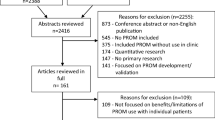Abstract
Purpose
To demonstrate how a previously described conceptual framework of physician–patient communication can inform the application of existing theory and the extension of new theory regarding the impact of patient-reported outcomes (PROs) in clinical practice.
Method
We used a communication framework to guide interpretation of empirical results relating to three situations: Collecting PROs from individual patients, providing individual patient’s PROs to his/her physician, and providing PROs from clinical trials to individual patients.
Results
For each of the selected situations, results of empirical studies of PROs are discussed in terms of the elements of the communication framework. These influences are developed into testable hypotheses regarding the impact of PROs and alternative hypotheses explaining empirical research results. We further illustrate how the conceptual framework can be knitted to other theories of communication to enhance understanding of the use of PROs in clinical practice.
Conclusion
Guidance of a conceptual framework of communication can enhance understanding of PRO study results and lead to testable hypotheses about how to further improve the clinical use of PROs.

Similar content being viewed by others
References
Kalmar, D. A., & Sternberg, R. J. (1988). Theory knitting: An integrative approach to theory development. Philosophical Psychology, 1, 153–170. doi:10.1080/09515088808572934.
Sprangers, M. A., Moinpour, C. M., Moynihan, T. J., Patrick, D. L., & Revicki, D. A. (2002). Assessing meaningful change in quality of life over time: A users’ guide for clinicians. Mayo Clinic Proceedings, 77, 561–571.
Greenhalgh, J., Long, A. F., & Flynn, R. (2005). The use of patient-reported outcome measures in routine clinical practice: Lack of impact or lack of theory? Social Science and Medicine, 60, 833–843. doi:10.1016/j.socscimed.2004.06.022.
Feldman-Stewart, D., Brundage, M. D., Tishelman, C., & SCRN Communication Team. (2005). A conceptual framework for patient-professional communication: An application to the cancer context. Psycho-Oncology, 14, 801–809. doi:10.1002/pon.950.
Berlo, D. K. (1960). The process of communication. New York: HOlt, Rinehart and Winston.
Riccardi, V. M., & Kurtz, S. M. (1983). Clinical Communication: Models and techniques. Communication and counseling in health care (pp. 29–51). Springfield: Charles C. Thomas.
Ross, R. S. (1970). Speech communication: fundamentals and practice. Englewoods Cliffs: Prentice-Hall.
Mead, N., & Bower, P. (2000). Patient-centredness: A conceptual framework and review of the empirical literature. Social Science and Medicine, 51, 1087–1110. doi:10.1016/S0277-9536(00)00098-8.
Brammer, L. M., & MacDonald, G. (2003). The helping relationship: Process and skills. Boston: Pearson Education Inc.
Shannon, C. E., & Weaver, W. (1949). The mathematical theory of communication. Urbana: University of Illinois Press.
MiIler, G. R. (1972). An introduction to speech communication. Indianapolis: The Bobbs-Merrill Company.
Dance, F. E. X. (1967). Toward a theory of human communication. In F. E. X. Dance (Ed.), Human communication theory (pp. 288–309). New York: Holt, Rinehart and Winston Inc.
Northouse, L. L., & Northouse, P. G. (1998). An introduction to health communication. In L. L. Northouse & P. G. Norhouse (Eds.), Health communication: Strategies for health professionals (pp. 1–21). Stanford: Appleton and Lange.
Bloom, S. W. (1963). The doctor and his patient. New York: Russell Sage Foundation.
Street, R. L. (2003). Communication in medical encounters: An ecological perspective. In T. Thomson, T. Thomson, A. M. Dorsey, K. I. Miller, & R. Parrott (Eds.), Handbook of health communication (pp. 63–89). Mahwah, NJ: Lawrence Erlbaum Associates.
Thorne, S. E., & Paterson, B. L. (2001). Health care professional support for self-care management in chronic illness: Insights from diabetes research. Patient Education and Counseling, 42, 81–90. doi:10.1016/S0738-3991(00)00095-1.
Makoul, G. (2001). Essential elements of communication in medical encounters: the Kalamazoo consensus statement. Academic Medicine, 76(4), 390–393. doi:10.1097/00001888-200104000-00021.
Maslow, A. H. (1954). Motivation and personality. Oxford: Harpers.
Velikova, G., Booth, L., Smith, A. B., Brown, P. M., Lynch, P., Brown, J. M., & Selby, P. J. (2004). Measuring quality of life in routine oncology practice improves communication and patient well-being: A randomized controlled trial. Journal of Clinical Oncology, 22, 714–724.
Marshall, S., Haywood, K., & Fitzpatrick, R. (2006). Impact of patient-reported outcome measures on routine practice. Journal of Evaluation in Clinical Practice, 12, 559–568. doi:10.1111/j.1365-2753.2006.00650.x.
Shapiro, S., Germino, B. B., Skinner, E. A., Vonkorff, M., Turner, R. W., Klein, L. E., et al. (1987). An experiment to change detection and management of mental morbidity in primary care. Medical Care, 25, 327–339. doi:10.1097/00005650-198704000-00006.
Wright, E. B., Holcombe, C., & Salmon, P. (2004). Doctors’ communication of trust, care and respect in breast cancer: Qualitative study. British Medical Journal (Clinical Research Ed.), 328: 864. doi:10.1136/bmj.38046.771308.7C.
Lavery, J. F., & Clarke, V. A. (1996). Causal attributions, coping strategies, and adjustments to breast cancer. Cancer Nursing, 19, 20–28. doi:10.1097/00002820-199602000-00003.
Brundage, M., Feldman-Stewart, D., Leis, A., Bezjak, A., & Pater, J. L. Patients’ judgements about the value quality of life information when considering lung cancer (NSCLS) treatment options. 2006 International Society for Quality of Life Research meeting abstracts. www.isoqol.org/2006mtgabstracts. The QLR Journal 2006: A-68.
Kennedy, A. P., Nelson, E., Reeves, D., Richardson, G., Roberts, C., Robinson, A., et al. (2004). A randomised controlled trial to assess the effectiveness and cost of a patient orientated self management approach to chronic inflammatory bowel disease. Gut, 53, 1639–1645. doi:10.1136/gut.2003.034256.
Author information
Authors and Affiliations
Corresponding author
Rights and permissions
About this article
Cite this article
Feldman-Stewart, D., Brundage, M.D. A conceptual framework for patient–provider communication: a tool in the PRO research tool box. Qual Life Res 18, 109–114 (2009). https://doi.org/10.1007/s11136-008-9417-3
Received:
Accepted:
Published:
Issue Date:
DOI: https://doi.org/10.1007/s11136-008-9417-3




